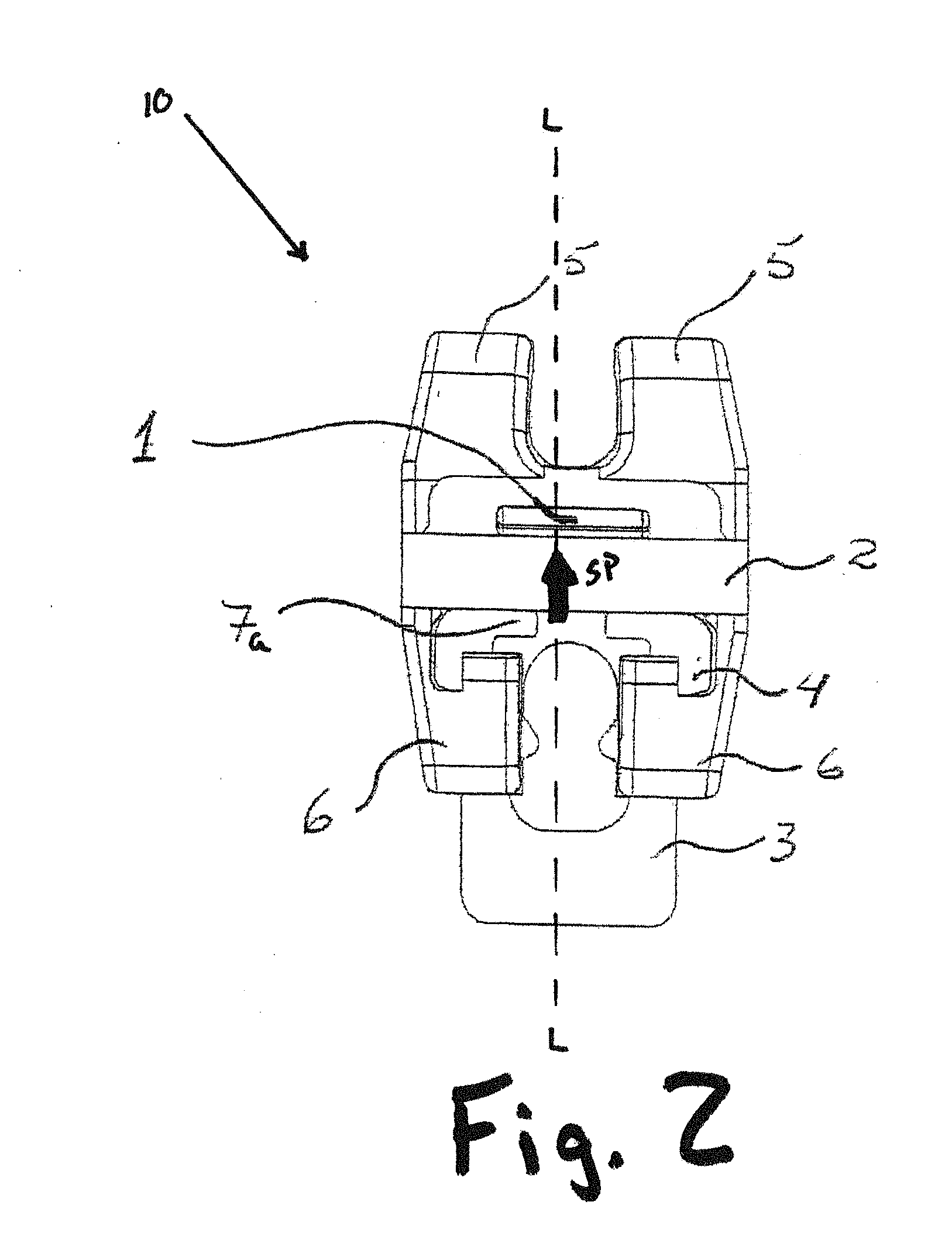Self ligating bracket system
a self-ligating, bracket technology, applied in the field of orthodontic bracket systems, can solve the problems of increasing the difficulty of orthodontic professionals using steel ligatures or elastomeric ligatures associated with conventional brackets, increasing the cost of specific procedures, and increasing the difficulty of orthodontic professionals using ligatures. , to achieve the effect of convenient replacement, improved fatigue resistance, and convenient orthodontists
- Summary
- Abstract
- Description
- Claims
- Application Information
AI Technical Summary
Benefits of technology
Problems solved by technology
Method used
Image
Examples
first embodiment
[0059]FIG. 1 illustrates a plan view of a self ligating orthodontic bracket 10 according to the present invention. The bracket 10 includes a bracket or housing 4 for attachment to the surface of a tooth, an archwire slot 2 defined by the housing 4 and configured to receive therein an archwire AW (FIG. 5), and a slidable ligating member or clip 3, illustrated in the closed or locked position, which retains the archwire AW in the archwire slot 2. The bracket 10 further includes a pair of upper tie wings 5 separated from a pair of opposing lower tie wings 6 by the archwire slot 2 defined therebetween.
[0060]It should be noted that the bracket 10 described herein, as well as any of the other embodiments of the inventive brackets, may have a base or lower surface configured to have a compound radius which may better adapt to the surface of the tooth.
[0061]Moreover, in the first embodiment as well as any of the later discussed embodiments, at least one of the upper tie wings 5 and the lowe...
second embodiment
[0070]FIG. 7 illustrates a plan view of a self ligating orthodontic bracket 110 according to the present invention.
[0071]The bracket 110 includes a self ligating orthodontic bracket or housing 14 for attachment to the surface of a tooth, an archwire slot 12 defined by the housing 14 and configured to receive therein the archwire AW, and a slidable ligating member or clip 13 illustrated in the closed or locked position which retains the archwire AW in the archwire slot 12. The bracket 110 further includes a pair of upper tie wings 15 separated from a pair of opposing lower tie wings 16 by the archwire slot 12 defined therebetween.
[0072]The clip 13 is configured to travel within the slide path SP defined by the upper and lower ties wings 15 and 16, respectively, in a direction that extends from the lower tie wings 16 to the upper tie wings 15 and which is transverse relative to the direction in which the archwire slot 12 extends. The clip 13 is preferably manufactured from a shape mem...
third embodiment
[0084]FIG. 13 illustrates a perspective view of a self ligating orthodontic bracket 210 according to the present invention.
[0085]The bracket 210 includes a bracket base 110a for attachment to the tooth surface, an archwire slot 102 configured to receive therein an archwire AW, and a slidable ligating member or clip 103 which retains the archwire AW in the archwire slot 102. The clip 103, like clips 3 and 13 of the first and second embodiments, can be selectively manipulated from the closed or locked state illustrated in FIG. 13 to the open or unlocked state, thereby exposing the archwire slot 102 extending transversely relative to the slide path SP traveled by the clip 103 in order to permit the orthodontic professional to place the archwire AW within the slot 102. The bracket 210 further includes a pair of upper tie wings 105 separated from a pair of opposing lower tie wings 106 by the archwire slot 102 defined therebetween.
[0086]The clip 103 is configured to travel along the slide...
PUM
 Login to View More
Login to View More Abstract
Description
Claims
Application Information
 Login to View More
Login to View More - R&D
- Intellectual Property
- Life Sciences
- Materials
- Tech Scout
- Unparalleled Data Quality
- Higher Quality Content
- 60% Fewer Hallucinations
Browse by: Latest US Patents, China's latest patents, Technical Efficacy Thesaurus, Application Domain, Technology Topic, Popular Technical Reports.
© 2025 PatSnap. All rights reserved.Legal|Privacy policy|Modern Slavery Act Transparency Statement|Sitemap|About US| Contact US: help@patsnap.com



